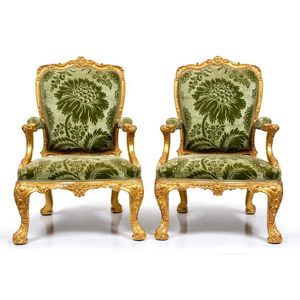A pair of exceptional carved and gilt-wood armchairs, English,…
A pair of exceptional carved and gilt-wood armchairs, English, circa 1820. English circa 1820. provenance: From the collection of the trustees of the 10th Duke of Argyll Inveraray Castle Scotland. Partridge, New Bond Street, London circa 1986. The Estate of Judith and Bruce Terry, Teychell, 16 Moule Avenue Brighton Victoria. Australia. Partridge noted in 1986, that these chairs formed part of a suite recorded as being re-upholstered in 1871, when the 9th Duke married H. R. H. Princess Louise Caroline Alberta, 4th daughter of Her Majesty Queen Victoria. The 9th Duke of Argyll. John Douglas Sutherland Campbell, Marquess of Lorne became the 9th Duke of Argyll on the death of his father in 1900. His home was Inveraray Castle- illustrated online. In 1870 Princess Louise, the most beautiful of Queen Victoria's daughters, was 22. Although not since 1515 had an English princess married outside a European, continental dynasty, she and the Queen now devised a private list of five British candidates. In September 1870, each was invited to spend a few days at Balmoral Castle. The last young man on the list and probably the most important in the eyes of the Queen and possibly Louise, was the Marquess of Lorne. Lord Lorne and Princess Louise were married in March 1871 at St George's Chapel in Windsor Castle. They soon moved into Kensington Palace, where the Queen had been brought up. In 1878 the Marquess was appointed Governor General of Canada by British Prime Minister Benjamin Disraeli. The 10th Duke of Argyll. Niall Diarmid Campbell (1872-1949) succeeded his uncle John Campbell, 9th Duke of Argyll as 10th Duke of Argyll in May 1914. The 10th Duke hated telephones and motor cars and would indulge in eccentric behaviour, including greeting tourists at Inveraray Castle with recitals from Italian operas. The Duke always wore the Campbell Tartan kilt when in the Highlands. Throughout his life, he was an antiquarian of note and had a very keen interest in history. Dimensions: 106 cm high, 70 cm wide, 73 cm deep
You must be a subscriber, and be logged in to view price and dealer details.
Subscribe Now to view actual auction price for this item
When you subscribe, you have the option of setting the currency in which to display prices to $Au, $US, $NZ or Stg.
This item has been sold, and the description, image and price are for reference purposes only.
- Circa - A Latin term meaning 'about', often used in the antique trade to give an approximate date for the piece, usually considered to be five years on either side of the circa year. Thus, circa 1900 means the piece was made about 1900, probably between 1895 and 1905. The expression is sometimes abbreviated to c.1900.
- Provenance - A term used to describe the provable history of an antique or work of art, and thus an additional aid to verifying its authenticity. Provenance can have an inflating effect on the price of an item, particularly if the provenance relates to the early settlement of Australia, a famous person, or royalty. Less significant are previous sales of the item through an auction house or dealer.
This item has been included into following indexes:
- British Prime Ministers - memorabilia 16
- chairs, singles / pairs / threes, style or period
